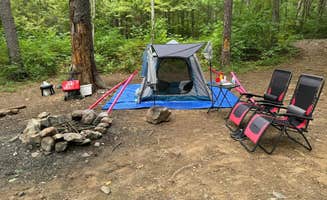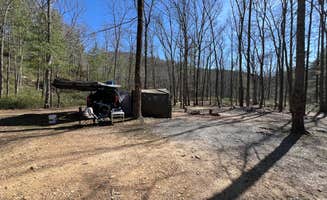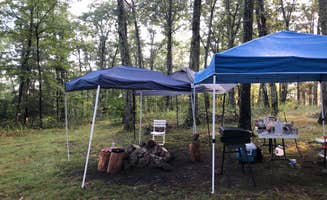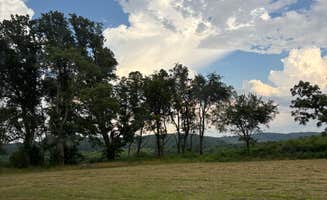Dispersed camping sites near Forest, Virginia offer primitive backcountry experiences within the mountains of central Virginia. Most locations sit at elevations between 1,200-2,500 feet with significant seasonal temperature variations. Spring brings frequent rainfall, creating muddy access roads, while fall offers cooler temperatures and colorful foliage displays across the surrounding Blue Ridge Mountains.
What to do
Creek fishing opportunities: George Washington National Forest off 812 provides access to small mountain streams. "There's access to the App Trail on the road so you might see some hikers but it was real quiet otherwise. Pretty nice scenery (you're smack in the middle of the forest)," notes Mark M. about the primitive camping options.
Hiking to panoramic viewpoints: Spy Rock requires a challenging uphill hike but rewards with exceptional views. "I camped here 3 times, the hike up is brutal but the top is absolutely worth it. This most recent time camping we discovered that apparently TECHNICALLY camping isn't allowed anymore, but the fire pit and tent areas still seem in use," shares Emily T. about this backcountry site.
Rock scrambling: Numerous bouldering opportunities exist near camping areas. "Another cool thing about this area is that there's some fairly nice bouldering to be found near the top. Some of the routes are a little under maintained and mossy, but there are some fun ones," explains a visitor to Johns Spring Shelter.
What campers like
Creek-side tent spots: Dispersed Camping Site off FR 812 offers secluded sites with running water nearby. "I was originally looking for a different camp site earlier on the road when I stumbled upon this one. It is a very rocky path, about 50 feet long, to get into the campground, but then it is smooth and well laid out," writes Jon N. about this group-friendly location.
Stone fire rings: Many sites feature established fire rings with thoughtful layouts. "There was a fire ring and man made stone oven at the site we chose," mentions Sawyer B., highlighting amenities at George Washington National Forest off 812 despite its primitive classification.
Solitude and wildlife: James River Wildlife Management Area provides quiet camping with minimal crowds. "I never saw another person camping... Everything else is fair game," notes L H. about the wildlife management area, emphasizing its spaciousness.
What you should know
Permit requirements: James River WMA requires a permit for overnight stays. "You simply need to purchase either a daily or annual access pass from the DWR website and then report which days you will be staying at the WMA—it's currently $23 for the annual pass," explains Zach K. about this budget-friendly option.
Water availability: Most sites lack reliable water sources. "There is not a water source too close to the shelter. The closest one is about 3 miles North," warns a camper about Johns Spring Shelter on the Appalachian Trail.
Cell service limitations: Expect minimal connectivity in most areas. "I had great T-Mobile service, but no ATT service—even with a powerful LTE antenna," reports a camper about connectivity at James River WMA, though conditions vary by location.
Tips for camping with families
Site selection strategies: Arrive early to secure flat, accessible sites. "Definitely get there early to get a prime spot. We didn't arrive until late afternoon but we were able to snag one down toward the end of the road," advises Sarah and James H. about camping at FR 812 sites.
Stream access for children: Several sites offer shallow water play areas. "Nice camping spot in George Washington NF. There are multiple spots along the road - some are drive in and some require you to park and walk in," notes a family about creek access.
Leave-no-trace reinforcement: Pack out all waste and teach children proper wilderness etiquette. "My only complaint - that whoever used it last decided to walk a few yards down the trail and use the bathroom right in the middle of the path, leaving their mess," warns a frustrated camper, highlighting the importance of proper waste disposal.
Tips from RVers
High-clearance vehicles recommended: Access roads to Reservoir Road sites require appropriate vehicles. "Went in August and it was very buggy, also had someone park pretty close which when I drive down a really long dirt road that is questionable for my van, i want it to be private and this was about 5 miles of dirt road to get to it," cautions SJ W. about the Reservoir Road access.
Limited turnaround space: Some primitive sites lack maneuvering room for larger vehicles. "Multiple road sites that fit my van with room to spare - 80% were full on a beautiful fall Friday evening around 6pm but still snagged one," mentions a van camper about FR 812 site accessibility.
Bug prevention essentials: Summer months bring significant insect activity. "Nice camping spots on the pedlar river in Amherst county," notes Derek D., though other reviewers mention August being particularly buggy at these riverside locations.






